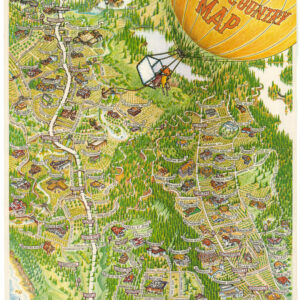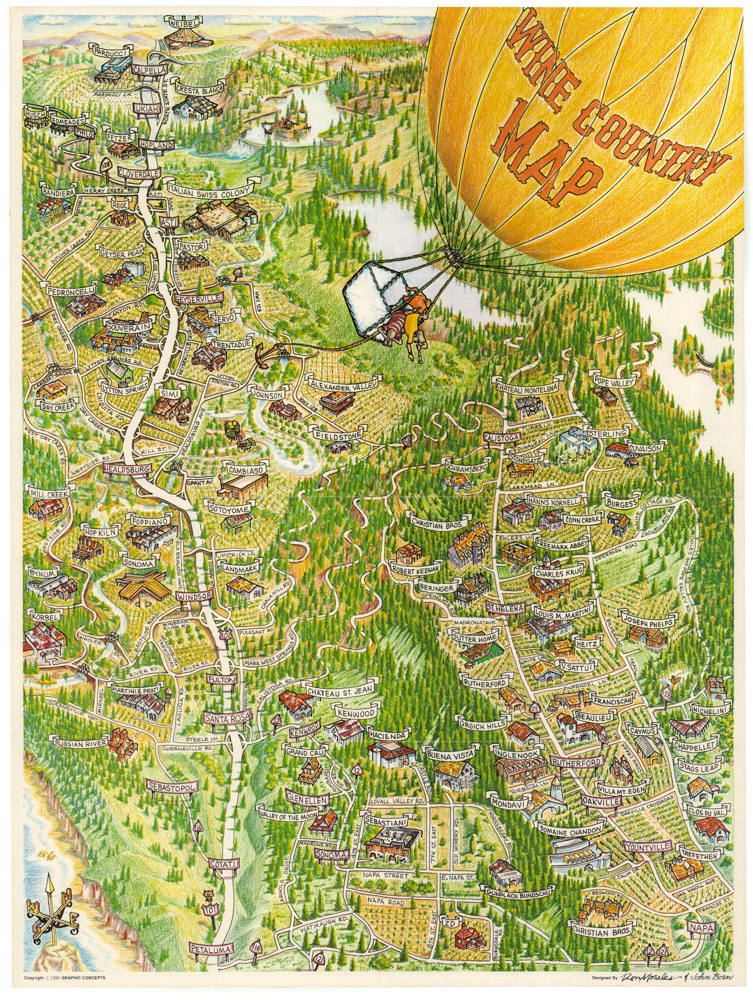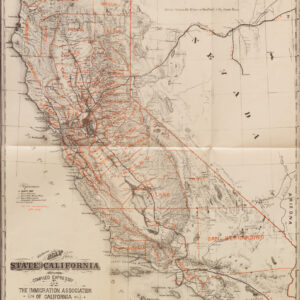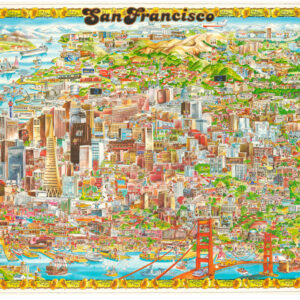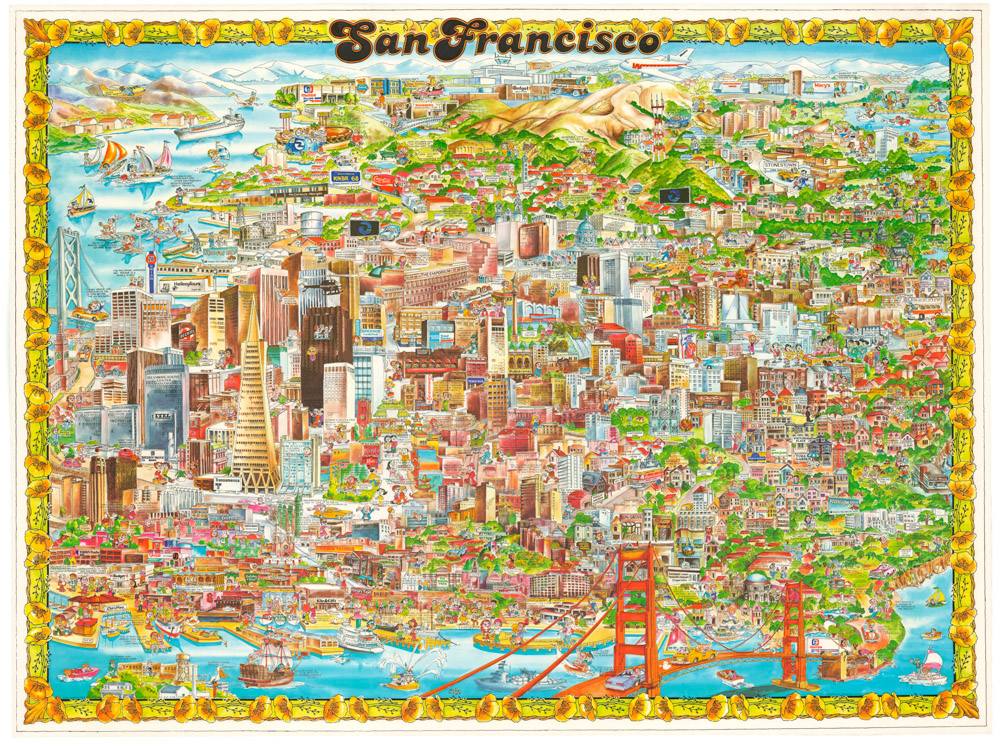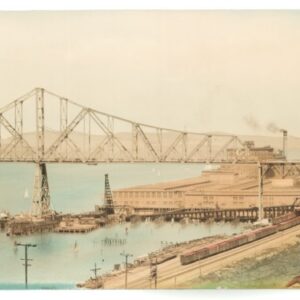An exceptional and monumental Gold Rush-era city plan of one of early California’s most prosperous river ports at its peak.
Official Map of the City of Marysville, California. Compiled by N. Wescoatt, City Surveyor, and W. S. Watson, Civil Engineer, from Recent Surveys by N. Wescoatt.
$4,500
1 in stock
Description
This monumental 1856 map of Marysville is one of the most impressive and ambitious examples of California Gold Rush–era urban cartography. Compiled by Nathaniel Wescoatt, City Surveyor of Marysville, and William S. Watson, Civil Engineer, and lithographed by Britton & Rey of San Francisco, the map captures in extraordinary detail the young city at the height of its prosperity as the principal commercial and transportation hub of the northern Sierra foothills.
The plan lays out the full street grid between the Yuba and Feather Rivers, each block and lot carefully numbered, reflecting the rapid formalization of property rights and city planning just seven years after Marysville’s founding. Surrounding tracts—such as the Pomeroy and Stephenson estates—are subdivided for sale, illustrating the speculative dynamism that characterized California’s river cities in the 1850s. Along the base of the sheet appear sixteen finely executed architectural vignettes of civic and commercial landmarks, including the Court House, City Hall, Marysville Academy, Bank Exchange, and Theatre, providing a rare visual record of Gold Rush architecture, much of which was lost to later floods and fires.
Executed on a grand scale, the map served both administrative and promotional purposes, combining cadastral precision with civic pride. It exemplifies the high technical standards of Britton & Rey, whose lithographic house dominated California map production in the 1850s and 1860s. The clarity of engraving, ornamental typography, and inclusion of local industry portraits suggest that the sheet was intended for official display—perhaps in the offices of the city council or land registry—underscoring Marysville’s ambitions to rival Sacramento and San Francisco as a regional capital.
Issued in 1856, at a moment when Marysville was the head of navigation on the Feather River and the gateway to the northern mines, this map documents a fleeting period when the city ranked among the most prosperous in California. It remains one of the finest surviving artifacts of California’s early civic cartography, bridging the speculative exuberance of the Gold Rush with the disciplined surveying of a maturing state.
Census
Fewer than ten examples are recorded in institutional or private collections: The Huntington Library (San Marino, CA) – mssHM 80211 (via Calisphere), the Amon Carter Museum of American Art (Fort Worth, TX) – Acc. no. 1972.102, the Bancroft Library, University of California, Berkeley – G4364.M3 1856 .W4, the California Historical Society (San Francisco, CA), the Library of Congress, Geography & Map Division (Washington, D.C.) – Official map … Wescoatt & Watson, 1856, and the Yuba County Library / Marysville City Museum (Marysville, CA).
Cartographer(s):
A. Boardman was a civil engineer and surveyor active in Northern California during the early years of statehood. Though details of his life remain scarce, contemporary city records and real estate notices identify him as one of several engineers and draftsmen working in Marysville and Sacramento during the 1850s, when local governments and land companies commissioned official maps to codify property boundaries amid the chaotic expansion of Gold Rush towns.
Boardman’s collaboration with C. W. Scammon on the 1856 Official Map of the City of Marysville suggests he was among the region’s small but skilled corps of professional surveyors who adapted military and coastal surveying techniques to rapidly urbanizing inland settlements. Boardman’s contribution reflects the technical hybridization of frontier engineering and civic cartography that characterized California’s early urban mapping projects.
Britton & ReyBritton & Rey (1852 – 1906) was a lithographic printing firm based in San Francisco and founded by Joseph Britton and Jacques Joseph Rey in 1852. Especially during the second half of the 19th century, Britton and Rey became the leading lithography firm in San Francisco, and probably California. Among their many publications were birds-eye-views of Californian cities, depictions of the exquisite landscapes, stock certificates, and no least maps. While Rey was the primary artist, Britton worked not only as the main lithographer but was essentially also the man running the business. In addition to their own material, the firm reproduced the works of other American artists like Thomas Almond Ayres (1816 – 1858), George Holbrook Baker (1824 – 1906), Charles Christian Nahl (1818 – 1878), and Frederick August Wenderoth (1819 – 1884). Following Rey’s death in 1892 Britton passed the form on to Rey’s son, Valentine J. A. Rey, who ran it until the great earthquake and fire of 1906 destroyed most of the company’s assets.
Joseph Britton (1825 – July 18, 1901) was a lithographer and the co-founder of the prominent San Francisco lithography studio Britton and Rey. He was also a civic leader in San Francisco, serving on the Board of Supervisors and helping to draft a new city charter. In 1852, he became active in lithography and publishing, first under the name ‘Pollard and Britton,’ and then ‘Britton and Rey,’ a printing company founded with his friend and eventual brother-in-law Jacques Joseph Rey. Britton and Rey became the premier lithographic and engraving studio of the Gold Rush era, producing letter sheets, maps, and artistic prints.
Jacques Joseph Rey (1820 – 1892) was a French engraver and lithographer born in the Alsatian town of Bouxwiller. At the age of about 30, he emigrated to America, eventually settling in California. Here, he soon entered into a partnership with local entrepreneur and civic leader Joseph Britton. Three years later, Rey also married Britton’s sister, allowing his business partner and brother-in-law Britton to live in their house with them. Rey and Britton were not only an important part of the San Francisco printing and publishing scene but also owned a plumbing and gas-fitting firm. In the early years, both men would sometimes partner up with others on specific projects, but by the late 1860s, their partnership was more or less exclusive.
Charles Melville ScammonThough best remembered as a naval officer, explorer, and naturalist, Charles M. Scammon also played a brief but notable role in early California cartography. Born in Pittston, Maine, Scammon came to California in 1849 as part of the Gold Rush, eventually joining the U.S. Coast Survey and working along the Pacific coast as a hydrographer and draughtsman. In the early 1850s, he participated in civil and harbor surveys throughout Northern California, producing several important manuscript and printed maps for local governments and land speculators, including the Official Map of the City of Marysville (1856), compiled with A. Boardman. His training in coastal navigation and topographic drafting lent the Marysville plan its unusually high level of technical precision.
After his surveying period, Scammon entered the whaling industry, where he achieved fame for discovering and charting the breeding lagoons of the gray whale on the Baja California coast—a feat that later informed his classic natural history The Marine Mammals of the North-Western Coast of North America (1874). Though his cartographic career was brief, his Marysville map remains one of the finest examples of mid-century urban surveying in Gold Rush California.
Nathaniel WescoattNathaniel Wescoatt was a civil engineer, surveyor, and city official active in Northern California during the height of the Gold Rush. Appointed City Surveyor of Marysville in the mid-1850s, he played a central role in formalizing the city’s cadastral and infrastructural layout as it transitioned from mining encampment to organized municipality. His Official Map of the City of Marysville (1856), compiled with fellow engineer W. S. Watson and lithographed by Britton & Rey, represents one of the earliest and most precise urban surveys undertaken in interior California. In contrast to the often speculative or hastily drawn plats of the period, Wescoatt’s plan demonstrates a rigor aligned with the emerging American urban engineering tradition, incorporating precise lot numbering, street alignment, and hydraulic data for a city bounded by two flood-prone rivers. Later records suggest that Wescoatt continued to work as a civil engineer in the Sacramento Valley, contributing to early canal and levee projects. His Marysville survey remains his most enduring legacy — a landmark in Gold Rush-era municipal cartography and a vital record of the professionalization of California’s early engineering corps.
William S. WatsonWilliam S. Watson was a civil and hydraulic engineer whose career spanned the formative decades of California’s statehood. Based in San Francisco and the northern interior, Watson collaborated with Nathaniel Wescoatt to compile the Official Map of the City of Marysville (1856), serving as consulting engineer on a number of early municipal and infrastructural projects. His technical training is evident in the map’s clean geometry and standardized surveying conventions, features that set it apart from the more pictorial Gold Rush city views of the same period. Like many engineers of his generation, Watson’s work straddled urban surveying, flood control, and railroad alignment, disciplines that were rapidly converging under the influence of eastern U.S. and British engineering models. Later references place him among the consulting engineers involved in early Central Valley reclamation efforts, though documentation is sparse. His contribution to the Marysville map situates him among the pioneering generation of civil engineers who transformed the ad hoc mining towns of the 1850s into enduring civic spaces.
Condition Description
Expertly restored and laid on linen by Green Dragon Bindery.
References
